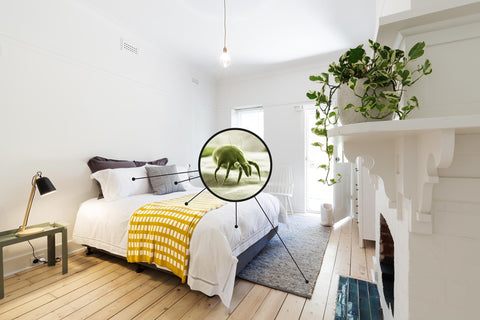
8 Myths about Dust-mites
Share
Dust mites are tiny parasites living in our house. They thrive in warm, humid environments, such as someone's home. Dust mites feed primarily on fallen skin cells. Dust mites are nearly impossible to get rid of entirely. However, there are steps a person can take to help rid their homes of most of these allergy-causing arthropods.

Myth #1: Dust allergic person allergic to the dust.
Fact: Everybody who thinks that has dust allergy is wrong, the right name of this allergy is dust-mite allergy. This is an allergic reaction to tiny bugs’ feces. We inhale dust mite feces and this causes allergic reactions in case of sensitive people. Signs of dust mite allergy include those common to hay fever, such as sneezing and runny nose. Many people with dust mite allergy also experience signs of asthma, such as wheezing and difficulty breathing.
Myth #2: Dust mites are found in dust.
Fact: Dust in your home is mostly made up of fallen human skin cells, hair and “other”. If you have animals in your home, it will contain a larger amount of animal dander as well. Sometimes dust mites are found in dust, but they don’t live there for long, especially if the dust is on a hard surface. They thrive in humid locations like your bed, they are also found in your fabric furniture (couches, chairs) and carpet. They are sometimes found in your curtains. They like stuffed animals, especially those allowed on the bed. Dust mites thrive in these areas because these are not normal places you clean for dust.
Myth #3: People with asthma don’t have to worry about dust mites.
Fact: Dust mites are a concern for people with dust mite allergy, many people with dust mite allergy also have eczema and asthma that is triggered by dust mites. But dust mites are also a problem people with asthma even if they aren't allergic to dust mites. The dust mite feces they create is considered an irritant that worsens indoor air pollution. The dust mite debris is then inhaled and is an irritant to inflamed lungs.
Myth #4: Dust mites are living in my bed.
Fact: Dust mites are living in humid and warm environments like beds, mattresses, pillows, carpets, curtains, stuffed animals and sofa. Numerous researches revealed that dust mite concentration is higher on the sofa than the bed, as when you get home you sit on the couch in your “dirty” clothes and this is how you infect the sofa with dust mites. Dust mites attach to your hair, clothing on the street, then you take into the house.
Myth #5: Dust mites are biting me!
Fact: Dust mites don’t have a mouth with teeth that is why they don’t bite you. Instead of chewing their food the way we do, they secrete an enzyme that breaks the food down and begins digestion. Dust mites don’t have a mouth, they don’t have teeth, they don’t chew, and they don’t bite!
Myth #6: Dust mites are escaping from my vacuum!
Fact: Dust mites aren’t mobile enough to crawl out of your vacuum cleaner. Dust mites (dead or alive) and their fragmented body parts, shed skins and feces only escape your vacuum cleaner if it leaks. Always vacuum with a HEPA-filtered vacuum to reduce dust mite allergens in homes.
Myth #7: Since dust mites are microscopic, they don't affect indoor air quality.
Fact: If you want to improve your indoor air quality, dust mite containment and prevention is a key step. Dust mite debris can become airborne, affecting indoor air quality.
Myth #8: Dusting is the best way to get rid of dust mites.
Fact: There are a few ways to prevent exposure to dust mites:
- Reduce humidity
- Clean regularly
- Ventilate more often!
There is more than one good solution against dust mites and one of these is Miteless Home. Miteless Home is a chemical-free, ultrasonic dust mite repellent that is totally safe to use beside babies and ill or pregnant women.

